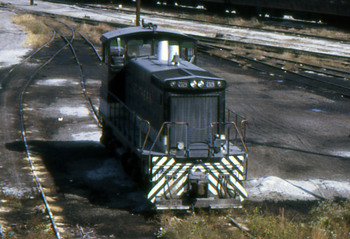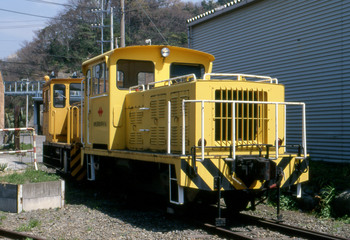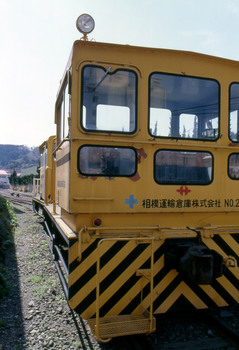Tigers and Zebras 03 – Chevrons and Diagonals [Column_Schemes & Paints]
 : Knoxville, TN. Winter, 1970
: Knoxville, TN. Winter, 1970One would draw inclined parallel lines to represent 3 dimensional parallel lines, such as cowcatcher, in 2 dimensions. Inclined parallel lines may make chevrons.
A way is to draw chevrons in the “upward” position. Another is to draw in the “downward” position. And the other is diagonal. Here, “downward” means the way SOU represented on SW1500, #2329 shown above. “upward” is the reverse.
SOU kept it a rule to draw chevrons downward. So as ATSF(on the front), CP, DRGW, GM&O, MEC, NKP, SAL, SCL, SP, WAB, WP, and others. CNW, CRR, MKT, NYC, PGE, RDG and others drew upward. BN, CP, and RT selected the diagonal. But, I found a weird case in Japan. Switchers of Sagami Unyu Soko adopted both upward and downward chevrons: No.1 had upward, while No.2 had downward. These switchers served U.S. Fleet Activities Yokosuka.
Most of the railroads drew 45 degrees chevrons. RDG drew steeper, and MKT drew more gently. Still more, some stripe’s width and Pitch are even, and some are not even.
Accordingly, there are so many ways to draw safety stripe on equipment. I believe that’s because cowcatcher is looked/read differently from which it is viewed.
 : Mar. 28, 1997 Yokosuka, Kanagawa, Japan
: Mar. 28, 1997 Yokosuka, Kanagawa, Japan : Mar. 28, 1997 Yokosuka, Kanagawa, Japan
: Mar. 28, 1997 Yokosuka, Kanagawa, Japan警戒塗装について話題にしてきた。
3次元にある平行線は、2次元上に傾きのある平行線として表現できる。カウ・キャッチャーを2次元上に表現したのが警戒塗装だ、という説について説明してきた。
さて、その表現方法には3通りある。ひとつは「上拡がり」、ひとつは「下拡がり」、そして「片流れ」である。
RDGやMKTなどは「上拡がり」を採用した。上に挙げたSOUやD&RGW、WPなどは「下拡がり」、BNやCPは「片流れ」と会社毎に決まっていた。「片流れ」の多くは70年代の導入だから、「上・下拡がり」からの派生とみていいだろう。
しかし、同一社の車両で、しかも連番であるにもかかわらず、統一されていないものもある。横須賀・田浦で見かけた相模運輸倉庫No.1および2である。
また、帯の角度は45度が一般的だが、RDGや先出の丸全昭和運輸のそれはより急角度、MKTのそれはより緩い角度で施されている。そして、帯の幅とピッチにも様々なものがある。
このように、警戒塗装の表現方法は色々である。もっとも効果的な表現をと、各々考えた結果だとするのが一般的だろう。しかし、それは見る角度によって違って見えるカウ・キャッチャーをその起源とするからこそ、というのが筆者の考えである。
2012-08-31 09:00
コメント(0)




コメント 0